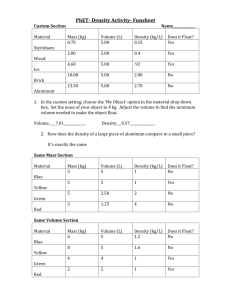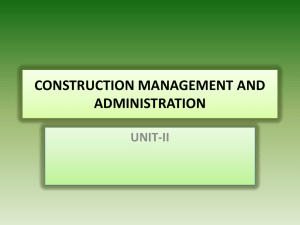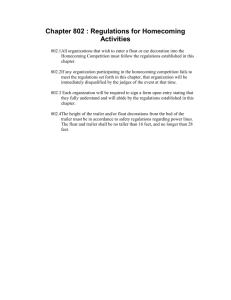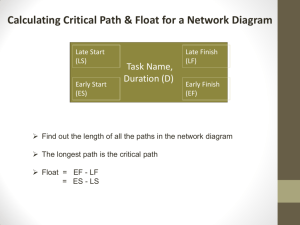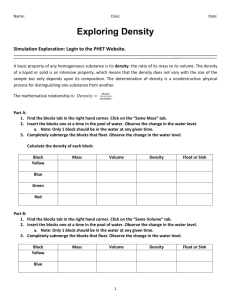Network Analysis
advertisement
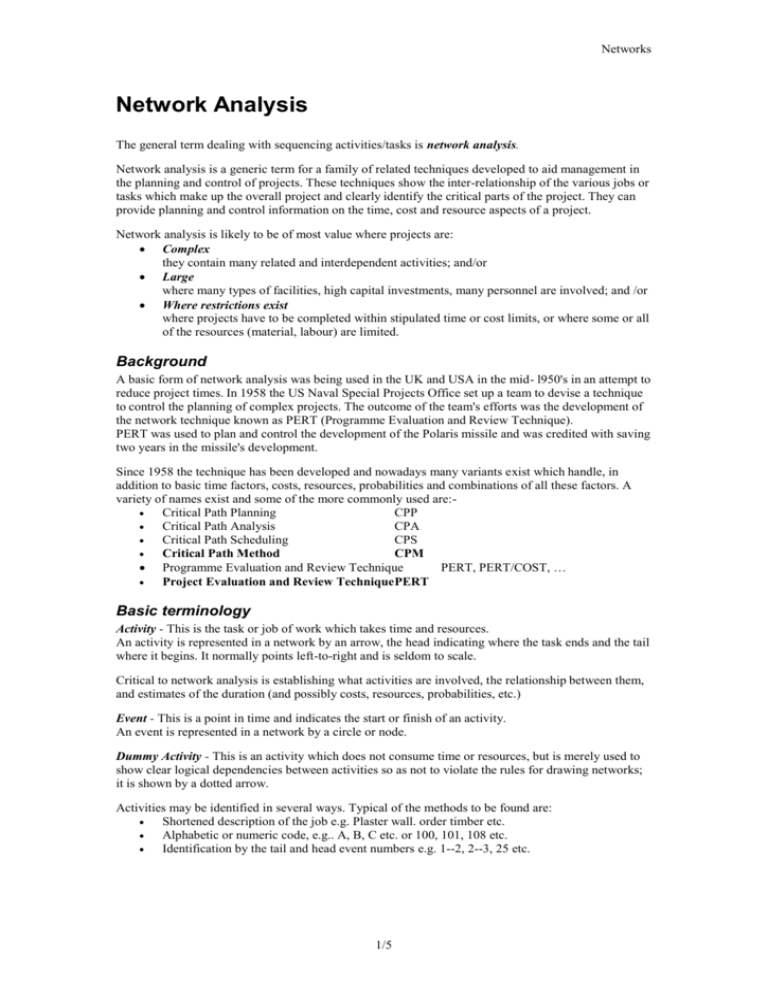
Networks Network Analysis The general term dealing with sequencing activities/tasks is network analysis. Network analysis is a generic term for a family of related techniques developed to aid management in the planning and control of projects. These techniques show the inter-relationship of the various jobs or tasks which make up the overall project and clearly identify the critical parts of the project. They can provide planning and control information on the time, cost and resource aspects of a project. Network analysis is likely to be of most value where projects are: Complex they contain many related and interdependent activities; and/or Large where many types of facilities, high capital investments, many personnel are involved; and /or Where restrictions exist where projects have to be completed within stipulated time or cost limits, or where some or all of the resources (material, labour) are limited. Background A basic form of network analysis was being used in the UK and USA in the mid- l950's in an attempt to reduce project times. In 1958 the US Naval Special Projects Office set up a team to devise a technique to control the planning of complex projects. The outcome of the team's efforts was the development of the network technique known as PERT (Programme Evaluation and Review Technique). PERT was used to plan and control the development of the Polaris missile and was credited with saving two years in the missile's development. Since 1958 the technique has been developed and nowadays many variants exist which handle, in addition to basic time factors, costs, resources, probabilities and combinations of all these factors. A variety of names exist and some of the more commonly used are: Critical Path Planning CPP Critical Path Analysis CPA Critical Path Scheduling CPS Critical Path Method CPM Programme Evaluation and Review Technique PERT, PERT/COST, … Project Evaluation and Review TechniquePERT Basic terminology Activity - This is the task or job of work which takes time and resources. An activity is represented in a network by an arrow, the head indicating where the task ends and the tail where it begins. It normally points left-to-right and is seldom to scale. Critical to network analysis is establishing what activities are involved, the relationship between them, and estimates of the duration (and possibly costs, resources, probabilities, etc.) Event - This is a point in time and indicates the start or finish of an activity. An event is represented in a network by a circle or node. Dummy Activity - This is an activity which does not consume time or resources, but is merely used to show clear logical dependencies between activities so as not to violate the rules for drawing networks; it is shown by a dotted arrow. Activities may be identified in several ways. Typical of the methods to be found are: Shortened description of the job e.g. Plaster wall. order timber etc. Alphabetic or numeric code, e.g.. A, B, C etc. or 100, 101, 108 etc. Identification by the tail and head event numbers e.g. 1--2, 2--3, 25 etc. 1/5 Networks Rules for drawing networks The following rules are all logically based and should be thoroughly learned before attempting to draw networks. A complete network should have only one point of entry - a START event and only one point of exit - a FINISH event. Every activity must have one preceding or 'tail' event and one succeeding or ‘head' event. Note that many activities may use the same tail event and many may use the head event. However an activity must not share the same tail event AND the same head event with any other activities (this is dealt with in detail in Dummies) . No activity can start until its tail event is reached. An event is not complete until all activities leading in to it are complete. This is an important rule and invariably has to be applied in examination questions. 'Loops' i.e. a series of activities which lead back to the same event are not allowed because the essence of networks is a progression of activities always moving onwards in time. All activities must be tied into the network i.e. they must contribute to the progression or be discarded as irrelevant. Activities which do not link into the overall project are termed 'danglers'. Conventions for drawing networks In addition to the Rules above, which must not be violated, certain conventions are usually observed: Networks proceed from left to right. Networks are not drawn to scale i.e. the length of the arrow does not represent time elapsed. Arrows need not be drawn in the horizontal plane but unless it is totally unavoidable they should proceed from left to right. If they are not already numbered, events or nodes should be progressively numbered from left to right. Simple networks may have events numbered in simple numeric progression i.e. 0, 1, 2, 3 etc. but larger, more realistic networks may be numbered in 'fives' i.e. 0, 5, 10, 15 etc. or 'tens' i.e. 0, 10, 20, 30 etc. This enables additional activities to be inserted subsequently without affecting the numbering sequence of the whole project. Exercise - Project XXX: building a boat Activity Preceding Activity A --B --C A D A E A F C G C H C J B, D K F, J L E, H, G, K M E, H N L, M Activity Description Design Hull Prepare Boat Shed Design Mast and Mast mount Obtain Hull Design Sails Obtain Mast Mount Obtain Mast Design rigging Prepare Hull Fit Mast Mount to Hull Step Mast Obtain Sails and Rigging Fit sails and Rigging Draw the network NB. The shape of the network is unimportant, but the logic must be correct. 2/5 Networks Exercise - Service station. The following tasks are to be completed on vehicles at a service station. Assume that all the jobs must be done, and that an unlimited number of people are available. The radiator, sump and battery are all located under the bonnet for the benefit of the exercise. Draw a network diagram. TASKS (Not necessarily in order) Preceding Task A Driver arrives and stops NONE B Driver selects brands of oil and petrol A C Fill petrol tank B D Prepare bill C and L E Receive payment and give stamps D F Wash windscreen A G Polish windscreen F H Check tyre pressure A J Inflate tyres H K Open bonnet A L Check oil requirement K M Add oil B and L N Add distilled water to battery K P Fill radiator K Q Close bonnet M, N and P R Driver departs from forecourt E, G, J and Q Time Analysis The main objective of network analysis is to establish the overall completion time of projects by calculating what is known as the Critical Path. Assessing The Time Once the logic has been agreed and the outline network drawn it can be completed by inserting the activity duration times. Time estimates. The analysis of project times can be achieved by using; Single time estimates for each activity. These estimates would be based on the judgement of the individual responsible or by technical calculations using data from similar projects, or Multiple time estimates for each activity. The most usual multiple time estimates are three estimates for each activity: Optimistic (O), Most Likely (ML) Pessimistic (P) These three estimates are combined to give an expected time and the accepted formula is: Expected time = (O + P + 4 ML) / 6 For example, assume that the three estimates for an activity are Optimistic 11 days Most likely 15 days Pessimistic 18 days then Expected Time = (11 + 18+4*(15)) / 6 = 14. 8 days Use of time estimates As the three time estimates are converted to a single time estimate there is no fundamental difference between the two methods as regards the basic time analysis of a network. However? on completion of the basic time analysis, projects with multiple time estimates can be further analysed to give an estimate of the probability of completing the project by a scheduled date. Time units Time estimates may be given in any unit i.e. minutes, hours, days, weeks, depending on the project. All times estimates within a project must be in the same units otherwise confusion is bound to occur 3/5 Networks Critical Path However sophisticated the time analysis becomes, a basic feature is always the calculation of the project duration which is the duration of the critical path. The critical path of a network gives the shortest time in which the whole project can be completed. It is the chain of activities with the longest duration times. There may be more than one critical path in a network and it is possible for the critical path to run through a dummy. Earliest start times (EST) Once the activities have been timed it is possible to assess the total project time by calculating the EST's for each activity. The EST is the earliest possible time at which a succeeding activity can start. Calculating EST (termed the FORWARD PASS) The EST of a head event is obtained by adding onto the EST of the tail event the linking activity duration starting from Event 0, time 0 and working forward through the network. Where two or more routes arrive at an event the LONGEST route time must be taken, e.g.. Activity F depends on completion of D and E. E is completed by day 5 but D is not complete until day 7 so F cannot start before day 7. The EST in the finish event is the project duration and is the shortest time in which the whole project can be completed. Latest start times (LST). To enable the critical path to be isolated, the LST for each activity must be established. The LST is the latest possible time at which a preceding activity can finish without increasing the project duration. Calculating LST (termed the BACKWARD PASS). Starting at the finish event, insert the LST and work backwards through the network deducting each activity duration from the previously calculated LST. Where the tails of two activities join an event, the lowest number is taken as the LST for that event otherwise the project would be delayed. Critical Path The critical path is the chain of activities which has the longest duration. The critical path can be indicated on the network either by a different colour or by two small transverse lines across the arrows along the path. The activities along the critical path are vital activities which must be completed by their EST's/LST's otherwise the project will be delayed. The non-critical activities have spare time or float available If it is required to reduce the overall project duration then the time of one or more of the activities on the critical path must be reduced perhaps by using more labour, or more or better equipment or some other method of reducing job times. A Crash Schedule is used to shorten the project by using overtime (or anything else?) regardless of cost. Note that for simple networks the critical path can be found by inspection, i.e. looking for the longest route, but the above procedure is necessary for larger projects and must be understood. The procedure is similar to that used by most computer programs dealing with network analysis. Float Float or spare time can only be associated with activities which are non-critical (since, by definition, activities on the critical path cannot have float.) There are three types of float, Total Float, Free Float and Independent Float. Total Float. This is the amount of time a path of activities could delayed without affecting the overall project duration. Total Float = Latest Head time - Earliest Tail time - Activity Duration Free Float. This is the amount of time an activity can be delayed without affecting the commencement of a subsequent activity at its earliest start time, but may affect float of previous activity. Free Float = Earliest Head time - Earliest Tail time - Activity Duration 4/5 Networks Independent float. This is the amount of time an activity an be delayed when all preceding activities are completed as late as possible and all succeeding activities completed as early as possible. Independent float therefore does not affect float of either preceding or subsequent activities. Independent float = Earliest Head time - Latest Tail time - Activity Duration The most important type of float is Total Float because it is involved with the overall project duration. On occasions the term 'Float' is used without qualification. In such cases assume that Total Float is required. Slack This is the difference between the EST and LST for each event. Strictly it does not apply to activities but on occasions the terms are confused and unless the context makes it abundantly clear that event slack is required, it is likely that some form of activity float is required. Events on the critical path have zero slack. Exercise - Service station The earlier problem, but with the times for the activities added. In addition, calculate the total float and free float for all activities. The following tasks are to be completed on vehicles at a service station. Assume that all the jobs must be done, and an unlimited number of people are available. The radiator, sump and battery are all located under the bonnet for the benefit of this exercise. TASKS (not necessarily in order) Time (Seconds) Preceding Task A Driver arrives and stops 20 NONE B Driver selects brands of oil and petrol 10 A C Fill petrol tank 100 B D Prepare bill 50 C and L E Receive payment and give stamps 50 D F Wash windscreen 20 A G Polish windscreen 20 F H Check tyre pressures 100 A J Inflate tyres 90 H K Open bonnet 20 A L Check oil requirement 80 K M Add oil 20 B and L N Add distilled water to battery 30 K P Fill radiator 30 K Q Close bonnet 10 M,N and P F Driver departs from forecourt 20 E, G, J and Q Exercise - Delta Limited Delta Ltd., in planning to introduce a new product, has listed the following necessary activities: Activity Preceding Activity Expected Time (weeks) A -6 B -3 C A 5 D A 4 E A 3 F C 3 G D 5 H B,D,E 5 I H 2 J F, G, I 3 Draw the critical path network for the project and determine the critical path and its duration. If the start of activity B is delayed by 3 weeks, activity E by 2 weeks and activity G by 2 weeks, how is the total time for the project affected? 5/5




